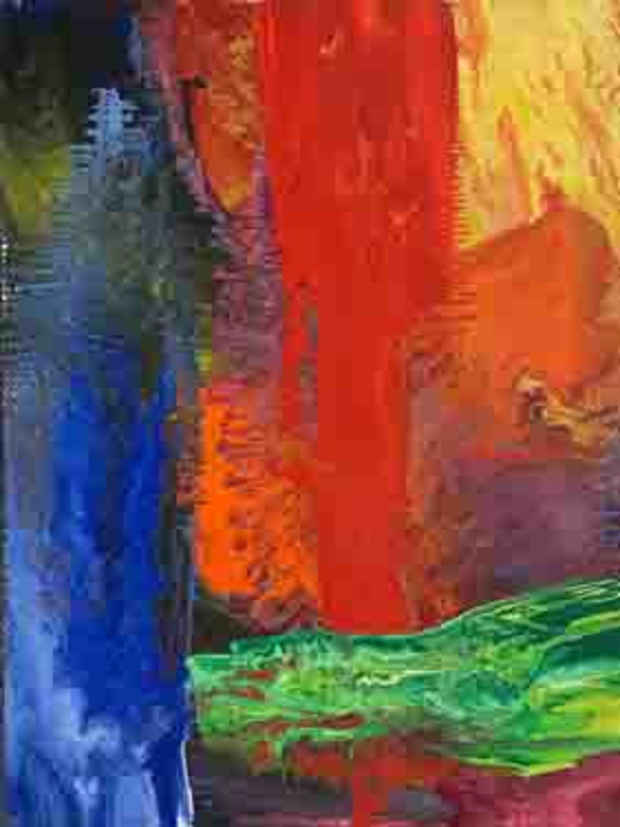Anthe Zacharias “Shaken, Not Stirred: 1970s Color Abstraction”
David Richard Gallery

[Image: Anthe Zacharias "Untitled (AZ 214)" (1972) Acrylic on canvas 113.5 x 84.5 in.]
This event has ended.
David Richard Gallery presents Shaken, Not Stirred: 1970s Color Abstraction, an exhibition by Anthe Zacharias and her second solo exhibition with the gallery. In the 1970s, Zacharias pushed the boundaries, both figuratively and literally, for exploring color in contemporary abstract painting and new processes for applying pigment to canvas. Not only was Zacharias bathing her canvases in paint, but she also explored the role of monumentality of the canvas, immersing the viewer in an experience with color and her vision for abstract painting. Her studio process became a physical performance and technical challenge while her canvases became more theatrical and heroic. This presentation examines several such brushless approaches for applying color to canvas as well as the impact of scale on the viewing experience.
Zacharias worked on both primed and unprimed canvases in the 1970s and relied mostly on pouring acrylic paint onto her canvases instead of brushing. That is when it became very imaginative and where the action began, in that she did not blend her colors prior to pouring, instead she used gravity and a range of physical methods to move, push and blend the colors in situ, thus, Shaken, Not Stirred. While gravity pours resulted in large swaths of color—either in straight lines or dramatic arcs depending upon the degree of tilting and moving of the canvas as the paint flowed—a much higher degree of mastery was required to create the more elaborate compositions, such as marbleizing and patterns reminiscent of bookend papers that required careful pouring as well as shaking and manipulating the wet paint to mix the colors while maintaining the individual hues. Zacharias also experimented with the medium and diluted the pigment at times to create translucent glazes. She also experimented with dry pigment that she added to the pours or scattered over the top to add explosions of color, additional blending, and texture to the surface. One of her more inventive and challenging techniques involved applying various colors in a thought-out design along a diagonal line, then folding the unpainted portion over the wet paint and peeling it back to create elaborate mirror images. Very interesting effects were created by combining this process at various locations and different scales around the canvas, some of the imagery became quite optical and trippy.
To explore monumentality of the canvas and the attendant technical hurdles as well as the visual benefits it might bring, required Zacharias to move to a different studio. She rented a dance studio in Providence, Rhode Island to give her the necessary space, both physically and mentally to think about her process and compositions. While Zacharias was not a color theorist per se, she had an intuitive sense for color and composition. Working at the grand scale of many of these paintings, her process was organic, making decisions on the fly based on the result of the prior paint addition or movement of the pigment. These processes were a combination of control and skill by the artist with a healthy dose of chance to create some very powerful imagery.
This exhibition will also present experimental and transitional works from the late 1960s that led up to the artist pouring the paint and applying physical methods of moving and blending the colors. Some of these transitional works look very similar, in that they are large with pours of paint. However, the pours were often tight and localized having defined and oval forms and large brushes were often used to move the paint, a vestige from the past that was quickly shed with full conversion to gravity, shimmying and shaking.
About Anthe Zacharias (b 1934):
Zacharias was born in Albania. Her parents immigrated to the United States and she grew up in New York on the west side of Manhattan in Hell’s Kitchen. She attended Queen’s College from 1952 to 1956 where she studied under art historian Robert Goldwater as well as John Ferren and Barse Miller. She then went to the University of California, Berkeley, where she met Mark di Suvero and studied with George McNeil and Erle Loran, receiving her M.F.A in 1957.
Returning to New York, Zacharias exhibited at the legendary March Gallery in the late 1950s and early 1960s alongside di Suvero and received recognition and mention form Dore Ashton. Between 1960 to 1968, she lived and painted in an old sea captain’s residence at Coentis Slip near South Ferry in the same area as some of the most renowned figures in the art scene of that time: Jasper Johns, Robert Rauschenberg, Barnett Newman, Ellsworth Kelly, Mark di Suvero, Agnes Martin, James Rosenquist and Robert Indiana.
In the mid-60s, Zacharias exhibited at the Great Jones Gallery along with Louise Bourgeois and in the early 1970s, at Green Mountain Gallery in Soho in Lower Manhattan. In the mid-1970s, Zacharias became somewhat reclusive and avoided exhibiting in galleries. However, she continued to paint every day in her studio and evolve her own visual language and experimental methods of application on new and novel supports. During the 1980s through 2000, she was closely associated with Socrates Sculpture Park in Long Island City, Queens and working with local children groups and teaching. She worked on two large commissions for the Park, including a brightly colored 35-foot mural. In 2006, Zacharias contributed a work to the “Peace Tower” shown at the Whitney Biennial of that same year. She continues to paint, albeit on a much smaller scale.
Media
Schedule
from October 30, 2019 to November 30, 2019
Opening Reception on 2019-11-03 from 16:00 to 19:00